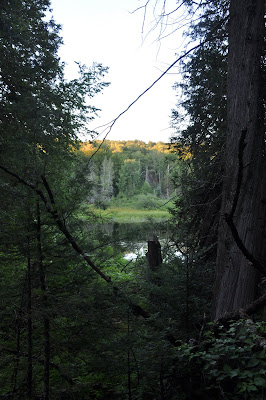Because I've been itching to get back out to the Peninsula Trail to check the rattlesnake plantains, and because all last week and this week I've been the only full-time employee "on" and thus unable to hit the trails, last night I decided our evening stroll would be at the VIC. So, donning leash (dog) and camera (me), we drove over and hit the trails.
The plantains were blooming - all over! I first saw one very small specimen, and was soon convinced we had a dwarf rattlesnake plantain. [A follow-up visit this morning (for better photos, sans dog) proved this was optimistically incorrect.]
I next came across a cluster - most of which were definitely
downy rattlesnake plantain (
Goodyera pubescens). One, however had paler leaves, and once more I was all excited thinking it might be checkered rattlesnake plantain. I checked it again this morning, getting a better look at the flowers, and I'm now satisfied that all the rattlesnake plantains I saw were downies. Here are some pics for your own evaluation:


Downies are known for their rather pouched lips, and they are the most common species.
By the time I had taken about a hundred photos, the sun was headed toward the horizon. It was about 8 PM.

We walked along the shoreline, just because it was there. I was thrilled to see
water lobelia (
Lobelia dormanna) in bloom, some standing in the water, others stranded up on the shore.

Gentians were suddenly everywhere, just within the treeline along the shore. Most common here is the
narrow-leaved gentian (
Gentiana linearis).

And then there was this plant. My first thought was "It's a pink bladderwort. I've never seen a
pink bladderwort." I took some pics and when I got back to the car I looked it up. Nada. There is a purple bladderwort, but the flower looks different. What can this be?

This morning I went back out to reevaluate this flower - details will be in my next post (ahh - suspense).
In the meantime, this tiny frog hopped by. It's a young
pickerel frog (
Rana palustris, although the genus is no longer
Rana; my field guide with the corrected name is in my car - will get back to you on that).

And if you want to see
cardinal flowers (
Lobelia cardinalis), now is the time to do it. I even saw a hummingbird checking them out this morning.

It was good to be out on the trails again!










































 The car had been under the tree when it fell. As you can see, the window is a bit scratched.
The car had been under the tree when it fell. As you can see, the window is a bit scratched.











